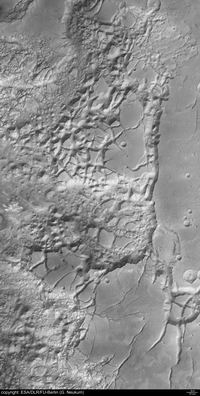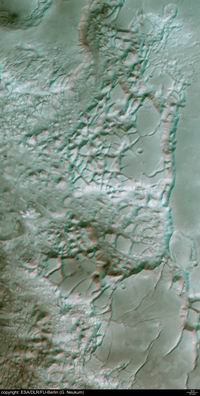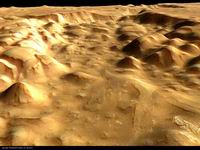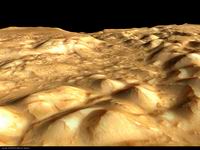Navigation/Menü: Links auf weitere Seiten dieser Website und Banner
22.04.2005
HRSC Press Release #156 - Aureum Chaos (orbit 0456)
 Am 30.5.2004 nahm die hochauflösende Stereokamera (HRSC) auf der ESA-Sonde Mars
Express im Orbit 456 einen Teil der Region Aureum Chaos mit einer Auflösung 25
Metern pro Bildpunkt auf. Die Abbildungen zeigen hiervon einen Ausschnitt bei 3°
südlicher Breite und 335° östlicher Länge.
Am 30.5.2004 nahm die hochauflösende Stereokamera (HRSC) auf der ESA-Sonde Mars
Express im Orbit 456 einen Teil der Region Aureum Chaos mit einer Auflösung 25
Metern pro Bildpunkt auf. Die Abbildungen zeigen hiervon einen Ausschnitt bei 3°
südlicher Breite und 335° östlicher Länge.
Aureum Chaos ist ein Teilgebiet der östlichen Ausläufer der Valles Marineris, etwa im Südwesten des 280 km umfassenden Impaktkraters Aram Chaos gelegen. Beide Gebiete sind Beispiele für eine besonders hervorstechende Oberflächenbeschaffenheit, die, als „Chaotic Terrain” bezeichnet, charakteristisch für die östlichen Ausläufer der Valles Marineris sind.
On 5 May 2004 the High-Resolution Stereo Camera (HRSC) onboard the ESA spacecraft Mars Express obtained image data in orbit 456 with a ground resolution of approximately 25 metres per pixel. The data were acquired in the region of Aureum Chaos, at approximately 3° southern latitude and 335° eastern longitude.
Aureum Chaos is located in the eastern part of Valles Marineris, southwest of the 280 km wide impact crater Aram Chaos. Like this impact basin, both regions are two examples of numerous regions in the eastern part of Valles Marineris that contain chaotic terrain.
 Der obere Bildbereich wird von dem Beginn eines Grabenbruchs mit ost-westlicher
Orientierung eingenommen, wobei seine Flanken sich durch Abrutschungen sowie
generell einer Vielzahl von Abschiebungsstrukturen gut abzeichnen.
Der obere Bildbereich wird von dem Beginn eines Grabenbruchs mit ost-westlicher
Orientierung eingenommen, wobei seine Flanken sich durch Abrutschungen sowie
generell einer Vielzahl von Abschiebungsstrukturen gut abzeichnen.
Im unteren Bilddrittel findet sich eine etwa 5 km breite Region, in der helles
Material mit einer möglicherweise subhorizontalen Schichtlagerung aufliegt.
Dieses könnte z.B. als Sublimations-ausfällungen im Zuge weitflächiger Flutungen
oder durch unterliegende subvulkanische Aktivität entstanden und anschließend
durch Erosionsprozesse freigelegt worden sein.
As the name chaos suggests, this terrain is characterized by randomly oriented,
large-scale mesas and knobs that are heavily eroded and dominate the morphology.
As seen in the color image, these mesas range from a few kilometres to tens of
kilometres wide. In the north of the image, a well-defined scarp extends in an
east-west direction, while slump and collapse blocks can be distinguished at the
base of this scarp, as highlighted in the close-up image.
Near the middle of the southern border of the color image, a roughly 5 km wide
region of bright material is observed. This material appears to form distinct
layers that may have been created by the evaporation of fluids or by
hydrothermal activity, see close-up image and lower right hand corner of the
perspective view. An interesting region of bright material extends north to
south in the centre of the color image and is also visible along the left side
of the perspective view.
 Teilweise aufliegend finden sich Spuren der helleren Schichtlagerung auch in
Form von Herausprägungen mit einer erkennbaren nord-südlichen Orientierung, die
zum unteren Bildrand hin breiter werden. Es lässt sich daher vermuten, dass
weitere Flächen des unmittelbaren Untergrundes von der Schichtlagerung
eingenommen werden, jedoch nicht oder nur sehr unvollständig aufliegen.
Teilweise aufliegend finden sich Spuren der helleren Schichtlagerung auch in
Form von Herausprägungen mit einer erkennbaren nord-südlichen Orientierung, die
zum unteren Bildrand hin breiter werden. Es lässt sich daher vermuten, dass
weitere Flächen des unmittelbaren Untergrundes von der Schichtlagerung
eingenommen werden, jedoch nicht oder nur sehr unvollständig aufliegen.
Insgesamt scheint primär eine fluidgestützte, oberflächliche Reliefbildung im
Zusammenhang mit der Mobilisierung unterliegenden Materials zu einem
weitflächigen Kollaps der Oberfläche geführt zu haben, dessen sekundär stark
erodierte Relikte als Chaotic Terrain namensgebend für die Region gewesen sind.
 The history of Aureum Chaos is complex and it appears that this basin was filled
with sediment and subsequently experienced the formation of chaotic terrain.
This extremely rough terrain is thought to be caused by collapse of the surface
due to the removal of subsurface ice, magma, or water.
The history of Aureum Chaos is complex and it appears that this basin was filled
with sediment and subsequently experienced the formation of chaotic terrain.
This extremely rough terrain is thought to be caused by collapse of the surface
due to the removal of subsurface ice, magma, or water.
 Durch die Bereitstellung neuer Bilder von Aureum Chaos ermöglicht es die HRSC
Kamera Wissenschaftlern, ihr Verständnis des Mars zu erweitern. Im speziellen
erlauben die Farb und Stereokapazitäten der HRSC Kamera weitergehende Studien
über die Marsmorphologie sowie Entwicklung von Landformen. Zusätzlich lassen
sich durch die spezielle Lage der einzelnen Kanäle im Reflexionsbereich
Informationen über spezifische Mineralien gewinnen, welche für geologische
Formationen eines Bildes charakteristisch sein können. Die Daten der HRSC
Kamera, kombiniert mit Informationen der weiteren Instrumente an Bord von Mars
Express sowie anderer Missionen werden deshalb neue Einsichten über die
geologische Entwicklung des roten Planeten ermöglichen und so auch den Weg für
zukünftige Missionen ebnen.
Durch die Bereitstellung neuer Bilder von Aureum Chaos ermöglicht es die HRSC
Kamera Wissenschaftlern, ihr Verständnis des Mars zu erweitern. Im speziellen
erlauben die Farb und Stereokapazitäten der HRSC Kamera weitergehende Studien
über die Marsmorphologie sowie Entwicklung von Landformen. Zusätzlich lassen
sich durch die spezielle Lage der einzelnen Kanäle im Reflexionsbereich
Informationen über spezifische Mineralien gewinnen, welche für geologische
Formationen eines Bildes charakteristisch sein können. Die Daten der HRSC
Kamera, kombiniert mit Informationen der weiteren Instrumente an Bord von Mars
Express sowie anderer Missionen werden deshalb neue Einsichten über die
geologische Entwicklung des roten Planeten ermöglichen und so auch den Weg für
zukünftige Missionen ebnen.
By supplying new image data for Aureum Chaos, the HRSC camera allows scientists
to improve their understanding of Mars. In particular, the color and stereo
capability of the HRSC camera allows for improved studies of the planet's
morphology- the evolution of rocks and land forms. Further, analyzing reflected
light at different wavelengths can indicate minerals that comprise various
geologic units within the scene. Data from the HRSC camera, coupled with
information from other instruments on Mars Express and other missions, will
provide new insights into the geologic evolution of the red planet and also pave
the way for future missions.
 Die Farbansichten wurden aus dem senkrecht blickenden Nadirkanal und den Farbkanälen erstellt, die Schrägansicht wurde aus den Stereokanälen der HRSC berechnet. Die Anaglyphen werden aus dem Nadirkanal und einem Stereokanal abgeleitet. Die schwarzweißen Detailaufnahmen wurden dem Nadirkanal entnommen, der von allen Kanälen die höchste Auflösung zur Verfügung stellt.
Die Farbansichten wurden aus dem senkrecht blickenden Nadirkanal und den Farbkanälen erstellt, die Schrägansicht wurde aus den Stereokanälen der HRSC berechnet. Die Anaglyphen werden aus dem Nadirkanal und einem Stereokanal abgeleitet. Die schwarzweißen Detailaufnahmen wurden dem Nadirkanal entnommen, der von allen Kanälen die höchste Auflösung zur Verfügung stellt.
The colour scenes have been derived from the three HRSC-colour channels and the nadir channel. The perspective views have been calculated from the digital terrain model derived from the stereo channels. The anaglyph image was calculated from the nadir and one stereo channel. The black and white high resolution images were derived form the nadir channel which provides the highest detail of all channels.
Das Kameraexperiment HRSC auf der Mission Mars Express der Europäischen Weltraumorganisation ESA wird vom Principal Investigator Prof. Dr. Gerhard Neukum (Freie Universität Berlin), der auch die technische Konzeption der hochauflösenden Stereokamera entworfen hatte, geleitet. Das Wissenschaftsteam besteht aus 40 Co-Investigatoren aus 33 Institutionen und zehn Nationen. Die Kamera wurde am Deutschen Zentrum für Luft- und Raumfahrt (DLR) unter der Leitung des Principal Investigators (PI) G. Neukum entwickelt und in Kooperation mit industriellen Partnern gebaut (EADS Astrium, Lewicki Microelectronic GmbH und Jena -Optronik GmbH). Sie wird vom DLR -Institut für Planetenforschung in Berlin-Adlershof betrieben. Die systematische Prozessierung der Daten erfolgt am DLR. Die Darstellungen wurden vom Institut für Geologische Wissenschaften der FU Berlin in Zusammenarbeit mit dem DLR-Institut für Planetenforschung erstellt.
The High Resolution Stereo Camera (HRSC) experiment on the ESA Mars Express Mission is led by the Principal Investigator (PI) Prof. Dr. Gerhard Neukum who also designed the camera technically. The science team of the experiment consists of 40 Co-Investigators from 33 institutions and 10 nations. The camera was developed at the German Aerospace Center (DLR) under the leadership of the PI G. Neukum and built in cooperation with industrial partners (EADS Astrium, Lewicki Microelectronic GmbH and Jena-Optronik GmbH). The experiment on Mars Express is operated by the DLR Institute of Planetary Research, through ESA/ESOC. The systematic processing of the HRSC image data is carried out at DLR. The scenes shown here were created by the PI-group at the Institute for Geological Sciences of the Freie Universitaet Berlin in cooperation with the German Aerospace Center (DLR), Institute of Planetary Research, Berlin.
© Copyright: ESA/DLR/FU Berlin (G. Neukum)
Download
hochaufgelöste Bilddaten / full resolution image data
| Nadiraufnahme / Grayscale Nadir Image | download TIF ( 16.2 MBs ) |
| RGB Farbbild / RGB Colour Image | download TIF ( 48.6 MBs ) |
| Rot-Cyan Anaglyphe / Red-cyan anaglyphe | download TIF ( 48.5 MBs ) |
| Perspektive / Perspective view | download TIF ( 72.2 MBs ) |
| Perspektive #2 / Perspective view #2 | download TIF ( 58 MBs ) |
| Perspektive #3 / Perspective view #3 | download TIF ( 58 MBs ) |
| Perspektive #4 / Perspective view #4 | download TIF ( 58 MBs ) |

 Deutsch
Deutsch

